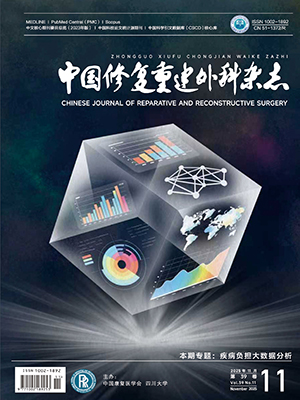Objective To study the effect of chitosan (CS) mediated insul in-l ike growth factor 1 gene (igf-1) transfection on the repair of articular cartilage defect. Methods Twelve 3-month-old healthy male rabbits weighting 2.0-2.5 kg were randomly divided into 2 primary groups, control and intervention groups (n=6 per group). Control group was further divided into normal control (left knee) and normal saline (NS) control (right knee) groups. While, intervention group was divided into CS (left knee) and CS/igf-1 intervention (right knee) groups. Cartilage defects were created in the knee joints except normal
control. Intra-articular injections of CS/igf-1 complex was administrated 2 times a week for 4 weeks in CS/igf-1 intervention
group, 0.5 mL CS in CS intervention group, and 0.5 mL sal ine solution in normal control and sal ine control groups. At 28
days after treatments, the cartilage samples were collected for histological observation and collagen type II and aggrecan mRNA evaluation. Results HE staining and toluidine blue staining revealed that CS/igf-1 and CS intervention could significantly stimulated cartilage regeneration accompanied with fibrosis and inflammatory cell infiltration, however, CS/igf-1 treatment resulted in the best repair of cartilage defect. In contrast, sal ine control group only showed fibrous tissue prol iferation and inflammatory cell infiltration without significant cartilage repairing. In terms of collagen type II and aggrecan gene expression, significant differences were observed in each pairwised comparison among 4 groups in the order of CS/igf-1 gt; CS gt; NS gt; normal control (P lt; 0.05). Conclusion In situ CS/ifg-1 complex transfection can enhance the formation of mesochondrium by upregulating collagen type II or aggrecan expression, which might enhance the repair of articular cartilage defect.
Citation: ZHAO Ronglan,REN Yuping,SUN Bei,ZHANG Rui,LIANG Dongchun. EXPERIMENTAL STUDY ON CHITOSAN MEDIATED INSULIN-LIKE GROWTH FACTOR GENE TRANSFECTION REPAIRING INJURED ARTICULAR CARTILAGE IN RABBITS. Chinese Journal of Reparative and Reconstructive Surgery, 2010, 24(11): 1372-1375. doi: Copy
Copyright © the editorial department of Chinese Journal of Reparative and Reconstructive Surgery of West China Medical Publisher. All rights reserved




